Principles of Administration Report: Office Management and Procedures
VerifiedAdded on 2020/07/23
|12
|2849
|78
Report
AI Summary
This report, focused on the principles of administration, provides a comprehensive analysis of office management practices. It begins by outlining legal requirements for managing office facilities, detailing typical services provided, and establishing effective office management procedures. The report then explores resource management, workflow techniques, and support services for office workers. Task 2 addresses legal obligations regarding employer health and safety, individual responsibilities, and accident/emergency procedures. Task 3 covers the purpose, legal implications, and accuracy of meeting minutes, including note-taking strategies. Task 4 examines different types of meetings, the roles of the chair and participants, facilitation techniques, and information requirements. Task 5 focuses on using targets and budgets for workload management, work allocation, and quality management techniques for administrative teams. Finally, Task 6 explores event characteristics, information sources, event planning, and information needed by delegates. The report concludes with a summary of key findings and references.
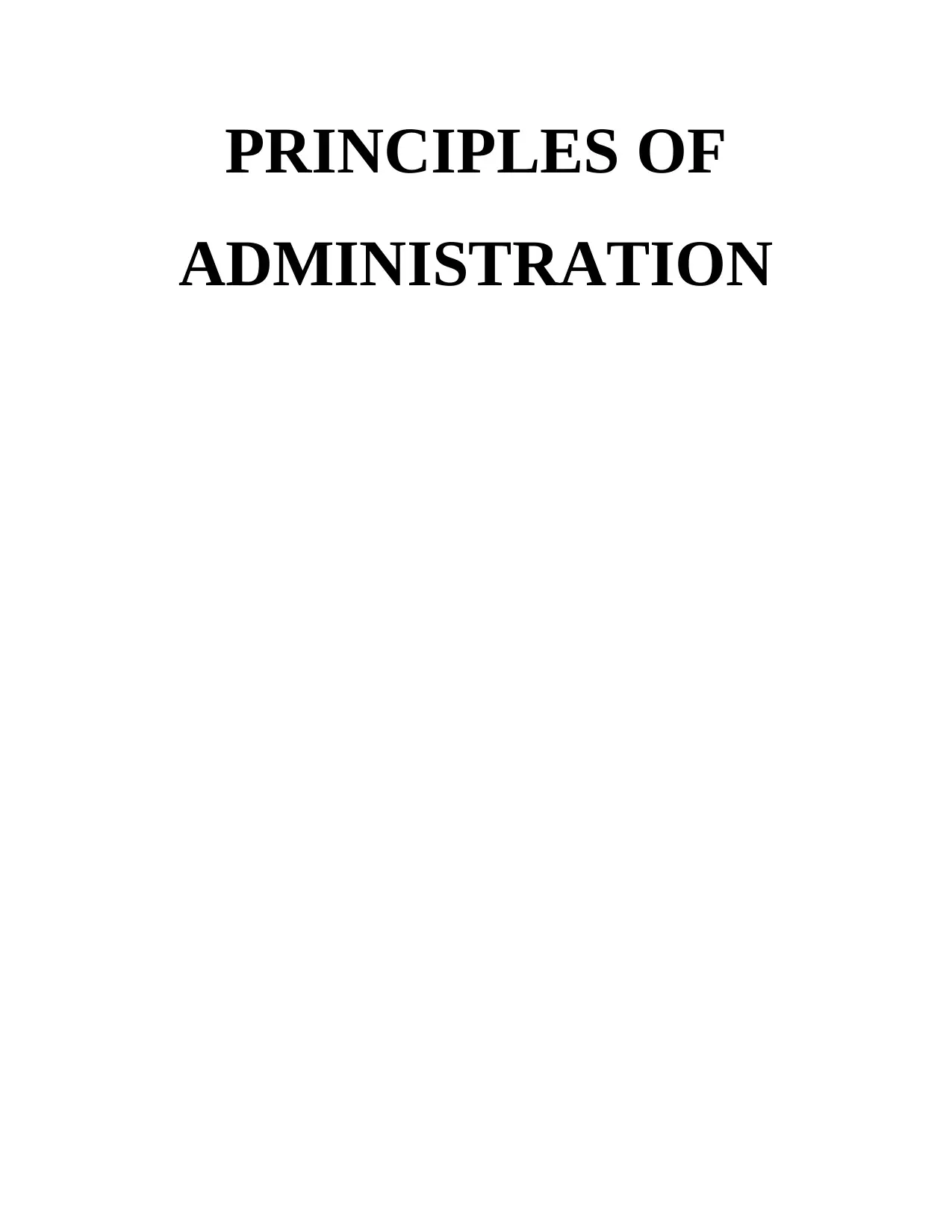
PRINCIPLES OF
ADMINISTRATION
ADMINISTRATION
Paraphrase This Document
Need a fresh take? Get an instant paraphrase of this document with our AI Paraphraser
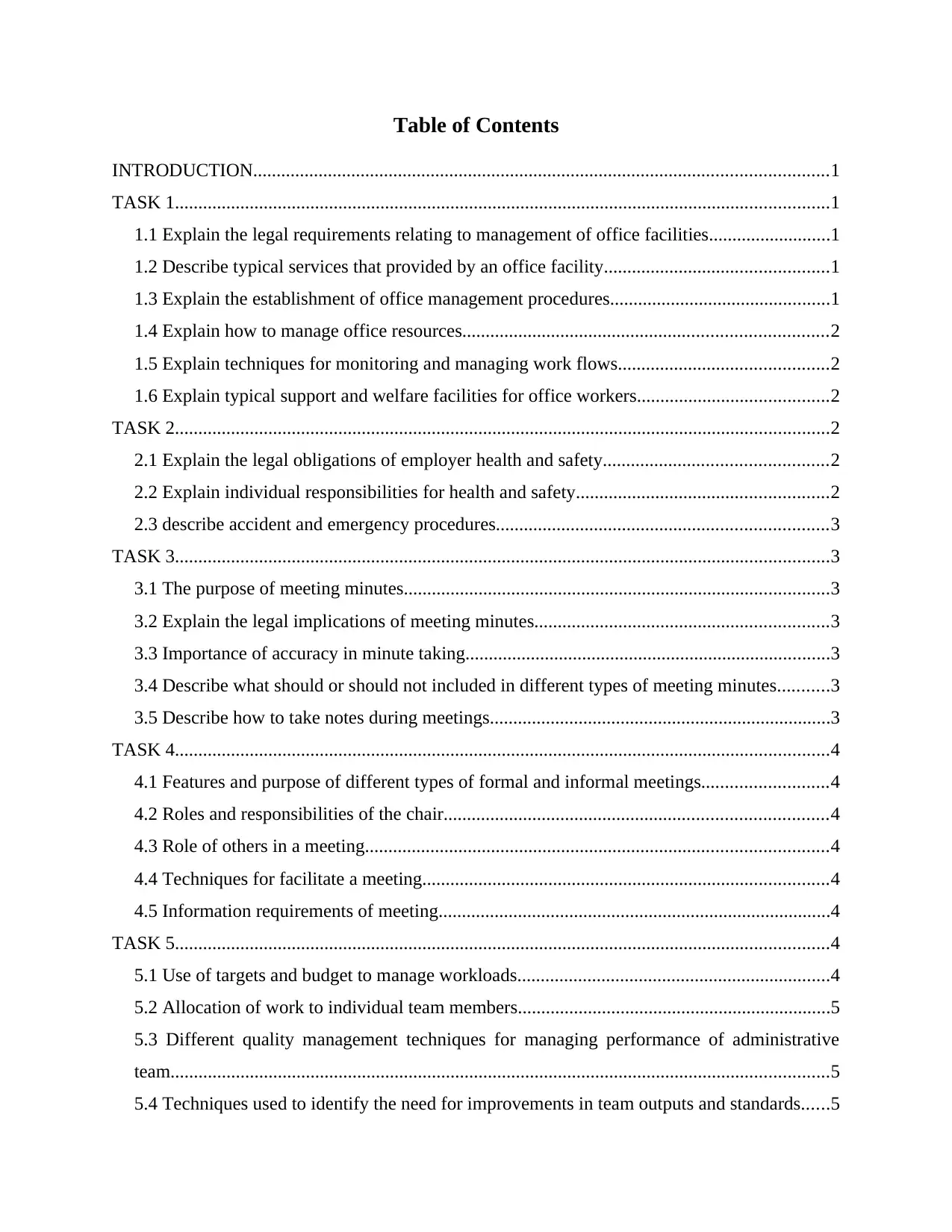
Table of Contents
INTRODUCTION...........................................................................................................................1
TASK 1............................................................................................................................................1
1.1 Explain the legal requirements relating to management of office facilities..........................1
1.2 Describe typical services that provided by an office facility................................................1
1.3 Explain the establishment of office management procedures...............................................1
1.4 Explain how to manage office resources..............................................................................2
1.5 Explain techniques for monitoring and managing work flows.............................................2
1.6 Explain typical support and welfare facilities for office workers.........................................2
TASK 2............................................................................................................................................2
2.1 Explain the legal obligations of employer health and safety................................................2
2.2 Explain individual responsibilities for health and safety......................................................2
2.3 describe accident and emergency procedures.......................................................................3
TASK 3............................................................................................................................................3
3.1 The purpose of meeting minutes...........................................................................................3
3.2 Explain the legal implications of meeting minutes...............................................................3
3.3 Importance of accuracy in minute taking..............................................................................3
3.4 Describe what should or should not included in different types of meeting minutes...........3
3.5 Describe how to take notes during meetings.........................................................................3
TASK 4............................................................................................................................................4
4.1 Features and purpose of different types of formal and informal meetings...........................4
4.2 Roles and responsibilities of the chair..................................................................................4
4.3 Role of others in a meeting...................................................................................................4
4.4 Techniques for facilitate a meeting.......................................................................................4
4.5 Information requirements of meeting....................................................................................4
TASK 5............................................................................................................................................4
5.1 Use of targets and budget to manage workloads...................................................................4
5.2 Allocation of work to individual team members...................................................................5
5.3 Different quality management techniques for managing performance of administrative
team.............................................................................................................................................5
5.4 Techniques used to identify the need for improvements in team outputs and standards......5
INTRODUCTION...........................................................................................................................1
TASK 1............................................................................................................................................1
1.1 Explain the legal requirements relating to management of office facilities..........................1
1.2 Describe typical services that provided by an office facility................................................1
1.3 Explain the establishment of office management procedures...............................................1
1.4 Explain how to manage office resources..............................................................................2
1.5 Explain techniques for monitoring and managing work flows.............................................2
1.6 Explain typical support and welfare facilities for office workers.........................................2
TASK 2............................................................................................................................................2
2.1 Explain the legal obligations of employer health and safety................................................2
2.2 Explain individual responsibilities for health and safety......................................................2
2.3 describe accident and emergency procedures.......................................................................3
TASK 3............................................................................................................................................3
3.1 The purpose of meeting minutes...........................................................................................3
3.2 Explain the legal implications of meeting minutes...............................................................3
3.3 Importance of accuracy in minute taking..............................................................................3
3.4 Describe what should or should not included in different types of meeting minutes...........3
3.5 Describe how to take notes during meetings.........................................................................3
TASK 4............................................................................................................................................4
4.1 Features and purpose of different types of formal and informal meetings...........................4
4.2 Roles and responsibilities of the chair..................................................................................4
4.3 Role of others in a meeting...................................................................................................4
4.4 Techniques for facilitate a meeting.......................................................................................4
4.5 Information requirements of meeting....................................................................................4
TASK 5............................................................................................................................................4
5.1 Use of targets and budget to manage workloads...................................................................4
5.2 Allocation of work to individual team members...................................................................5
5.3 Different quality management techniques for managing performance of administrative
team.............................................................................................................................................5
5.4 Techniques used to identify the need for improvements in team outputs and standards......5
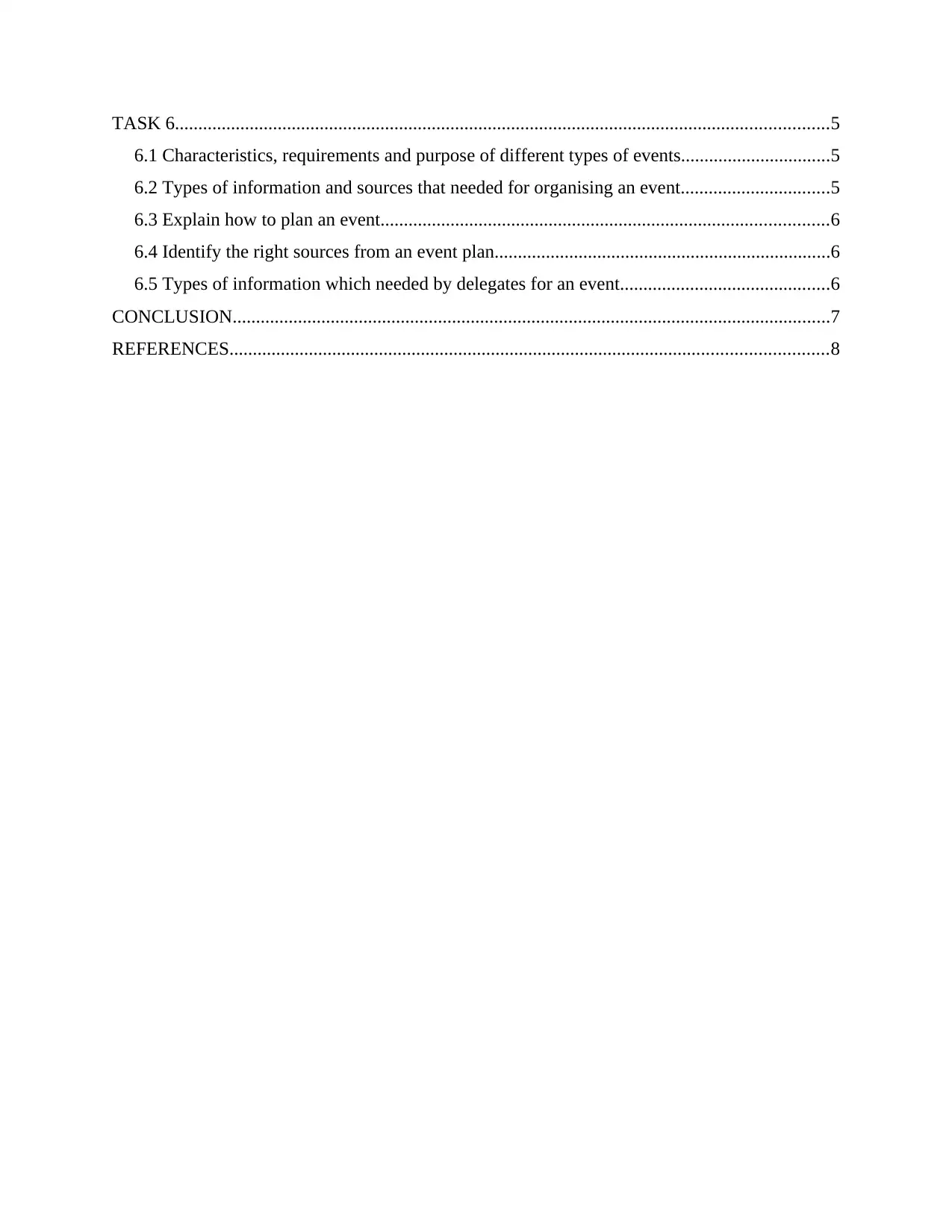
TASK 6............................................................................................................................................5
6.1 Characteristics, requirements and purpose of different types of events................................5
6.2 Types of information and sources that needed for organising an event................................5
6.3 Explain how to plan an event................................................................................................6
6.4 Identify the right sources from an event plan........................................................................6
6.5 Types of information which needed by delegates for an event.............................................6
CONCLUSION................................................................................................................................7
REFERENCES................................................................................................................................8
6.1 Characteristics, requirements and purpose of different types of events................................5
6.2 Types of information and sources that needed for organising an event................................5
6.3 Explain how to plan an event................................................................................................6
6.4 Identify the right sources from an event plan........................................................................6
6.5 Types of information which needed by delegates for an event.............................................6
CONCLUSION................................................................................................................................7
REFERENCES................................................................................................................................8
⊘ This is a preview!⊘
Do you want full access?
Subscribe today to unlock all pages.

Trusted by 1+ million students worldwide

Paraphrase This Document
Need a fresh take? Get an instant paraphrase of this document with our AI Paraphraser
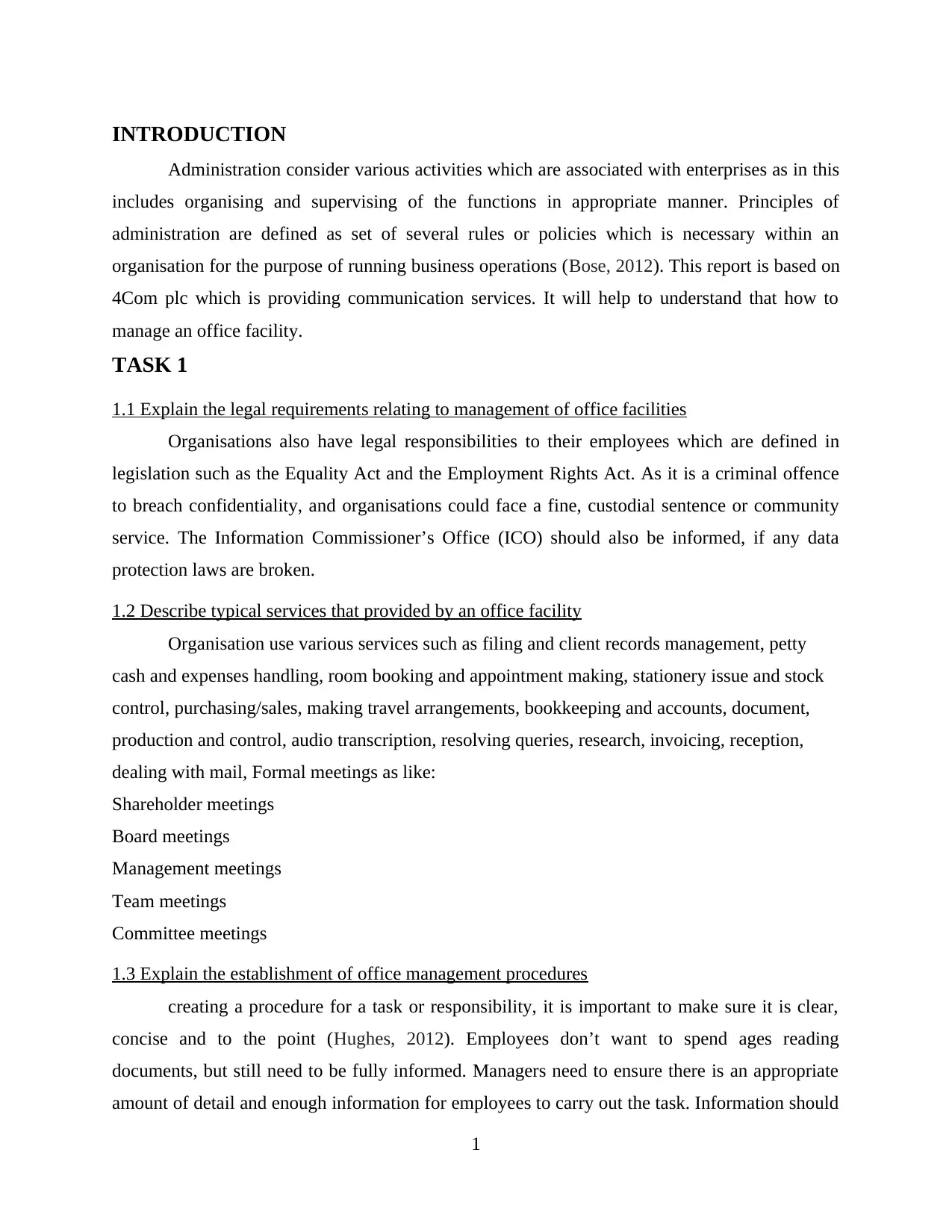
INTRODUCTION
Administration consider various activities which are associated with enterprises as in this
includes organising and supervising of the functions in appropriate manner. Principles of
administration are defined as set of several rules or policies which is necessary within an
organisation for the purpose of running business operations (Bose, 2012). This report is based on
4Com plc which is providing communication services. It will help to understand that how to
manage an office facility.
TASK 1
1.1 Explain the legal requirements relating to management of office facilities
Organisations also have legal responsibilities to their employees which are defined in
legislation such as the Equality Act and the Employment Rights Act. As it is a criminal offence
to breach confidentiality, and organisations could face a fine, custodial sentence or community
service. The Information Commissioner’s Office (ICO) should also be informed, if any data
protection laws are broken.
1.2 Describe typical services that provided by an office facility
Organisation use various services such as filing and client records management, petty
cash and expenses handling, room booking and appointment making, stationery issue and stock
control, purchasing/sales, making travel arrangements, bookkeeping and accounts, document,
production and control, audio transcription, resolving queries, research, invoicing, reception,
dealing with mail, Formal meetings as like:
Shareholder meetings
Board meetings
Management meetings
Team meetings
Committee meetings
1.3 Explain the establishment of office management procedures
creating a procedure for a task or responsibility, it is important to make sure it is clear,
concise and to the point (Hughes, 2012). Employees don’t want to spend ages reading
documents, but still need to be fully informed. Managers need to ensure there is an appropriate
amount of detail and enough information for employees to carry out the task. Information should
1
Administration consider various activities which are associated with enterprises as in this
includes organising and supervising of the functions in appropriate manner. Principles of
administration are defined as set of several rules or policies which is necessary within an
organisation for the purpose of running business operations (Bose, 2012). This report is based on
4Com plc which is providing communication services. It will help to understand that how to
manage an office facility.
TASK 1
1.1 Explain the legal requirements relating to management of office facilities
Organisations also have legal responsibilities to their employees which are defined in
legislation such as the Equality Act and the Employment Rights Act. As it is a criminal offence
to breach confidentiality, and organisations could face a fine, custodial sentence or community
service. The Information Commissioner’s Office (ICO) should also be informed, if any data
protection laws are broken.
1.2 Describe typical services that provided by an office facility
Organisation use various services such as filing and client records management, petty
cash and expenses handling, room booking and appointment making, stationery issue and stock
control, purchasing/sales, making travel arrangements, bookkeeping and accounts, document,
production and control, audio transcription, resolving queries, research, invoicing, reception,
dealing with mail, Formal meetings as like:
Shareholder meetings
Board meetings
Management meetings
Team meetings
Committee meetings
1.3 Explain the establishment of office management procedures
creating a procedure for a task or responsibility, it is important to make sure it is clear,
concise and to the point (Hughes, 2012). Employees don’t want to spend ages reading
documents, but still need to be fully informed. Managers need to ensure there is an appropriate
amount of detail and enough information for employees to carry out the task. Information should
1
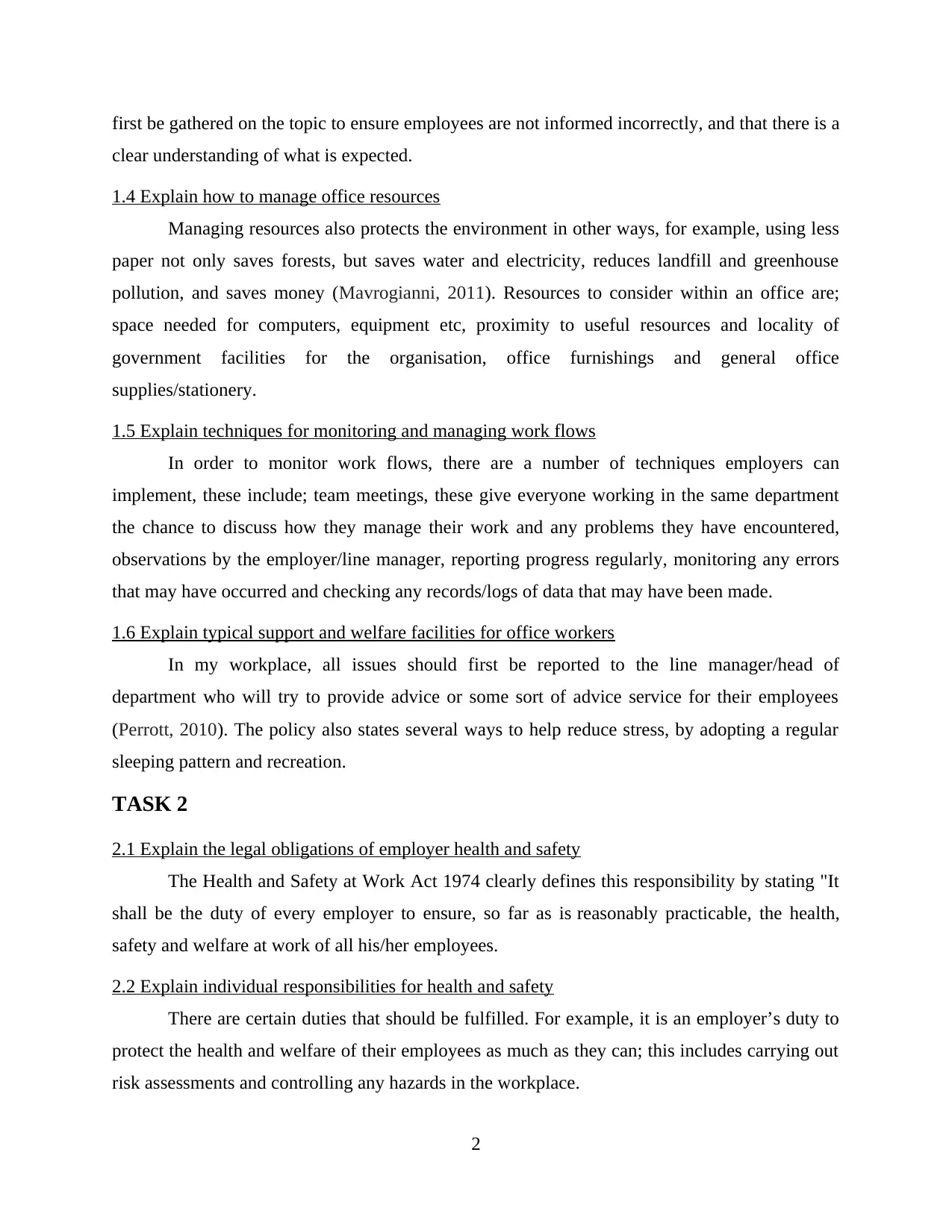
first be gathered on the topic to ensure employees are not informed incorrectly, and that there is a
clear understanding of what is expected.
1.4 Explain how to manage office resources
Managing resources also protects the environment in other ways, for example, using less
paper not only saves forests, but saves water and electricity, reduces landfill and greenhouse
pollution, and saves money (Mavrogianni, 2011). Resources to consider within an office are;
space needed for computers, equipment etc, proximity to useful resources and locality of
government facilities for the organisation, office furnishings and general office
supplies/stationery.
1.5 Explain techniques for monitoring and managing work flows
In order to monitor work flows, there are a number of techniques employers can
implement, these include; team meetings, these give everyone working in the same department
the chance to discuss how they manage their work and any problems they have encountered,
observations by the employer/line manager, reporting progress regularly, monitoring any errors
that may have occurred and checking any records/logs of data that may have been made.
1.6 Explain typical support and welfare facilities for office workers
In my workplace, all issues should first be reported to the line manager/head of
department who will try to provide advice or some sort of advice service for their employees
(Perrott, 2010). The policy also states several ways to help reduce stress, by adopting a regular
sleeping pattern and recreation.
TASK 2
2.1 Explain the legal obligations of employer health and safety
The Health and Safety at Work Act 1974 clearly defines this responsibility by stating "It
shall be the duty of every employer to ensure, so far as is reasonably practicable, the health,
safety and welfare at work of all his/her employees.
2.2 Explain individual responsibilities for health and safety
There are certain duties that should be fulfilled. For example, it is an employer’s duty to
protect the health and welfare of their employees as much as they can; this includes carrying out
risk assessments and controlling any hazards in the workplace.
2
clear understanding of what is expected.
1.4 Explain how to manage office resources
Managing resources also protects the environment in other ways, for example, using less
paper not only saves forests, but saves water and electricity, reduces landfill and greenhouse
pollution, and saves money (Mavrogianni, 2011). Resources to consider within an office are;
space needed for computers, equipment etc, proximity to useful resources and locality of
government facilities for the organisation, office furnishings and general office
supplies/stationery.
1.5 Explain techniques for monitoring and managing work flows
In order to monitor work flows, there are a number of techniques employers can
implement, these include; team meetings, these give everyone working in the same department
the chance to discuss how they manage their work and any problems they have encountered,
observations by the employer/line manager, reporting progress regularly, monitoring any errors
that may have occurred and checking any records/logs of data that may have been made.
1.6 Explain typical support and welfare facilities for office workers
In my workplace, all issues should first be reported to the line manager/head of
department who will try to provide advice or some sort of advice service for their employees
(Perrott, 2010). The policy also states several ways to help reduce stress, by adopting a regular
sleeping pattern and recreation.
TASK 2
2.1 Explain the legal obligations of employer health and safety
The Health and Safety at Work Act 1974 clearly defines this responsibility by stating "It
shall be the duty of every employer to ensure, so far as is reasonably practicable, the health,
safety and welfare at work of all his/her employees.
2.2 Explain individual responsibilities for health and safety
There are certain duties that should be fulfilled. For example, it is an employer’s duty to
protect the health and welfare of their employees as much as they can; this includes carrying out
risk assessments and controlling any hazards in the workplace.
2
⊘ This is a preview!⊘
Do you want full access?
Subscribe today to unlock all pages.

Trusted by 1+ million students worldwide
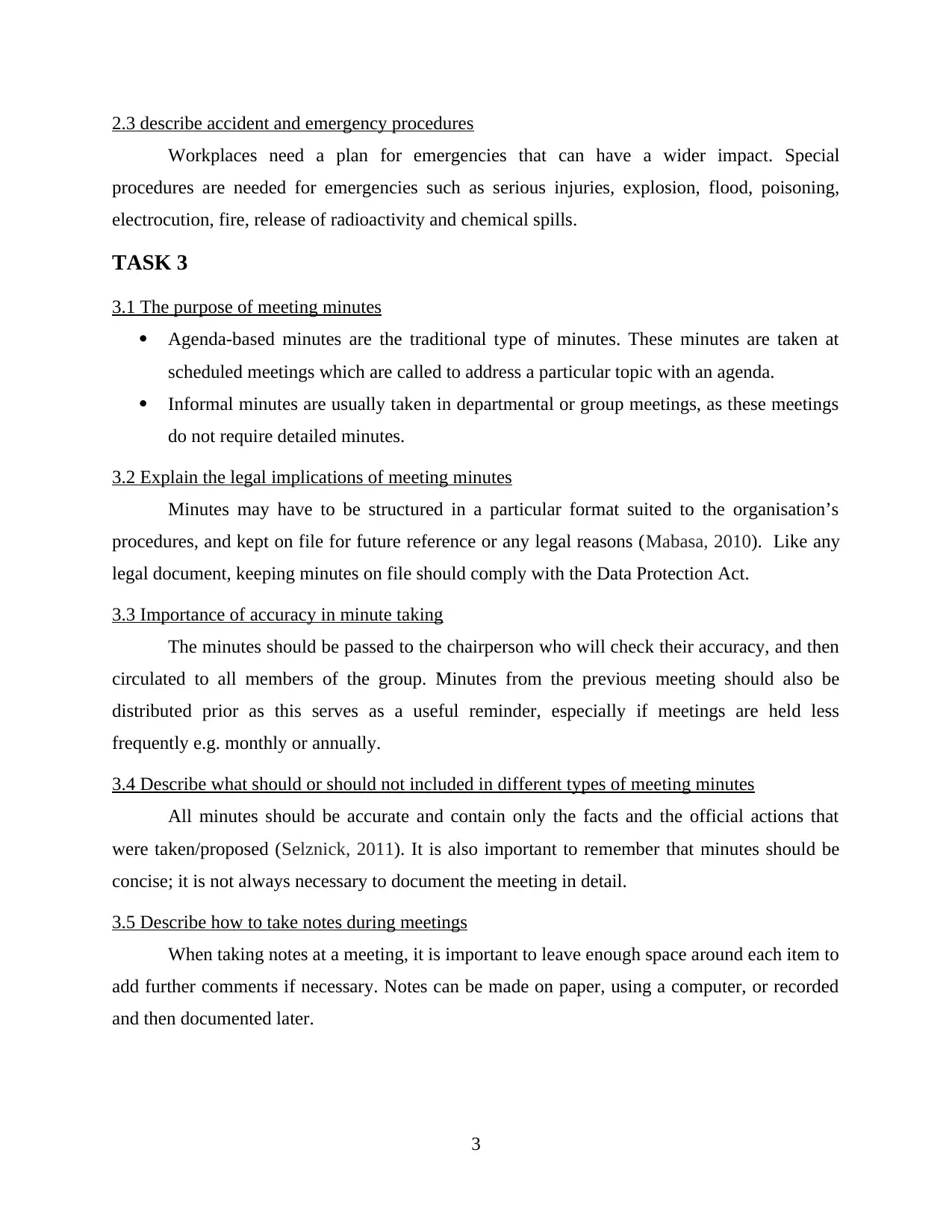
2.3 describe accident and emergency procedures
Workplaces need a plan for emergencies that can have a wider impact. Special
procedures are needed for emergencies such as serious injuries, explosion, flood, poisoning,
electrocution, fire, release of radioactivity and chemical spills.
TASK 3
3.1 The purpose of meeting minutes
Agenda-based minutes are the traditional type of minutes. These minutes are taken at
scheduled meetings which are called to address a particular topic with an agenda.
Informal minutes are usually taken in departmental or group meetings, as these meetings
do not require detailed minutes.
3.2 Explain the legal implications of meeting minutes
Minutes may have to be structured in a particular format suited to the organisation’s
procedures, and kept on file for future reference or any legal reasons (Mabasa, 2010). Like any
legal document, keeping minutes on file should comply with the Data Protection Act.
3.3 Importance of accuracy in minute taking
The minutes should be passed to the chairperson who will check their accuracy, and then
circulated to all members of the group. Minutes from the previous meeting should also be
distributed prior as this serves as a useful reminder, especially if meetings are held less
frequently e.g. monthly or annually.
3.4 Describe what should or should not included in different types of meeting minutes
All minutes should be accurate and contain only the facts and the official actions that
were taken/proposed (Selznick, 2011). It is also important to remember that minutes should be
concise; it is not always necessary to document the meeting in detail.
3.5 Describe how to take notes during meetings
When taking notes at a meeting, it is important to leave enough space around each item to
add further comments if necessary. Notes can be made on paper, using a computer, or recorded
and then documented later.
3
Workplaces need a plan for emergencies that can have a wider impact. Special
procedures are needed for emergencies such as serious injuries, explosion, flood, poisoning,
electrocution, fire, release of radioactivity and chemical spills.
TASK 3
3.1 The purpose of meeting minutes
Agenda-based minutes are the traditional type of minutes. These minutes are taken at
scheduled meetings which are called to address a particular topic with an agenda.
Informal minutes are usually taken in departmental or group meetings, as these meetings
do not require detailed minutes.
3.2 Explain the legal implications of meeting minutes
Minutes may have to be structured in a particular format suited to the organisation’s
procedures, and kept on file for future reference or any legal reasons (Mabasa, 2010). Like any
legal document, keeping minutes on file should comply with the Data Protection Act.
3.3 Importance of accuracy in minute taking
The minutes should be passed to the chairperson who will check their accuracy, and then
circulated to all members of the group. Minutes from the previous meeting should also be
distributed prior as this serves as a useful reminder, especially if meetings are held less
frequently e.g. monthly or annually.
3.4 Describe what should or should not included in different types of meeting minutes
All minutes should be accurate and contain only the facts and the official actions that
were taken/proposed (Selznick, 2011). It is also important to remember that minutes should be
concise; it is not always necessary to document the meeting in detail.
3.5 Describe how to take notes during meetings
When taking notes at a meeting, it is important to leave enough space around each item to
add further comments if necessary. Notes can be made on paper, using a computer, or recorded
and then documented later.
3
Paraphrase This Document
Need a fresh take? Get an instant paraphrase of this document with our AI Paraphraser
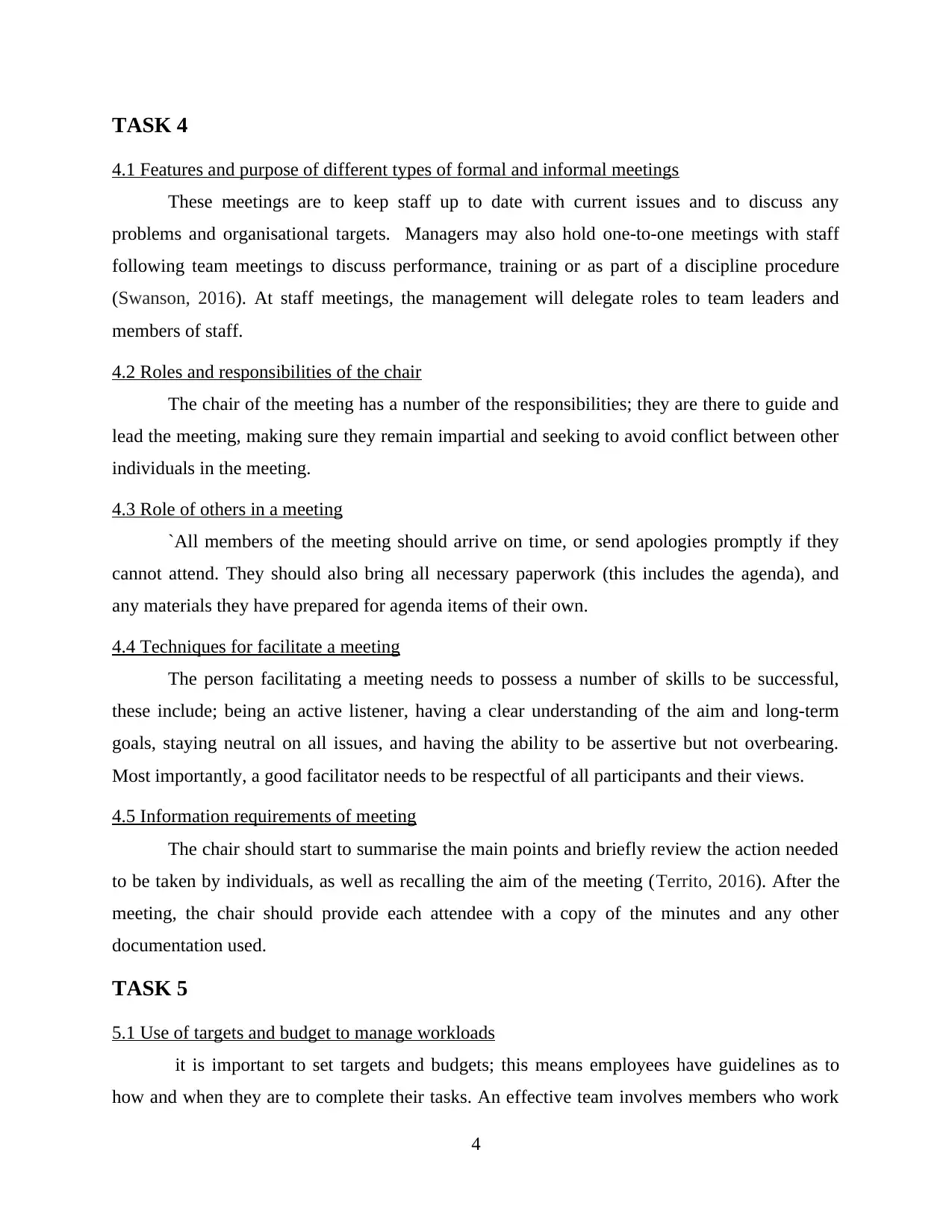
TASK 4
4.1 Features and purpose of different types of formal and informal meetings
These meetings are to keep staff up to date with current issues and to discuss any
problems and organisational targets. Managers may also hold one-to-one meetings with staff
following team meetings to discuss performance, training or as part of a discipline procedure
(Swanson, 2016). At staff meetings, the management will delegate roles to team leaders and
members of staff.
4.2 Roles and responsibilities of the chair
The chair of the meeting has a number of the responsibilities; they are there to guide and
lead the meeting, making sure they remain impartial and seeking to avoid conflict between other
individuals in the meeting.
4.3 Role of others in a meeting
`All members of the meeting should arrive on time, or send apologies promptly if they
cannot attend. They should also bring all necessary paperwork (this includes the agenda), and
any materials they have prepared for agenda items of their own.
4.4 Techniques for facilitate a meeting
The person facilitating a meeting needs to possess a number of skills to be successful,
these include; being an active listener, having a clear understanding of the aim and long-term
goals, staying neutral on all issues, and having the ability to be assertive but not overbearing.
Most importantly, a good facilitator needs to be respectful of all participants and their views.
4.5 Information requirements of meeting
The chair should start to summarise the main points and briefly review the action needed
to be taken by individuals, as well as recalling the aim of the meeting (Territo, 2016). After the
meeting, the chair should provide each attendee with a copy of the minutes and any other
documentation used.
TASK 5
5.1 Use of targets and budget to manage workloads
it is important to set targets and budgets; this means employees have guidelines as to
how and when they are to complete their tasks. An effective team involves members who work
4
4.1 Features and purpose of different types of formal and informal meetings
These meetings are to keep staff up to date with current issues and to discuss any
problems and organisational targets. Managers may also hold one-to-one meetings with staff
following team meetings to discuss performance, training or as part of a discipline procedure
(Swanson, 2016). At staff meetings, the management will delegate roles to team leaders and
members of staff.
4.2 Roles and responsibilities of the chair
The chair of the meeting has a number of the responsibilities; they are there to guide and
lead the meeting, making sure they remain impartial and seeking to avoid conflict between other
individuals in the meeting.
4.3 Role of others in a meeting
`All members of the meeting should arrive on time, or send apologies promptly if they
cannot attend. They should also bring all necessary paperwork (this includes the agenda), and
any materials they have prepared for agenda items of their own.
4.4 Techniques for facilitate a meeting
The person facilitating a meeting needs to possess a number of skills to be successful,
these include; being an active listener, having a clear understanding of the aim and long-term
goals, staying neutral on all issues, and having the ability to be assertive but not overbearing.
Most importantly, a good facilitator needs to be respectful of all participants and their views.
4.5 Information requirements of meeting
The chair should start to summarise the main points and briefly review the action needed
to be taken by individuals, as well as recalling the aim of the meeting (Territo, 2016). After the
meeting, the chair should provide each attendee with a copy of the minutes and any other
documentation used.
TASK 5
5.1 Use of targets and budget to manage workloads
it is important to set targets and budgets; this means employees have guidelines as to
how and when they are to complete their tasks. An effective team involves members who work
4
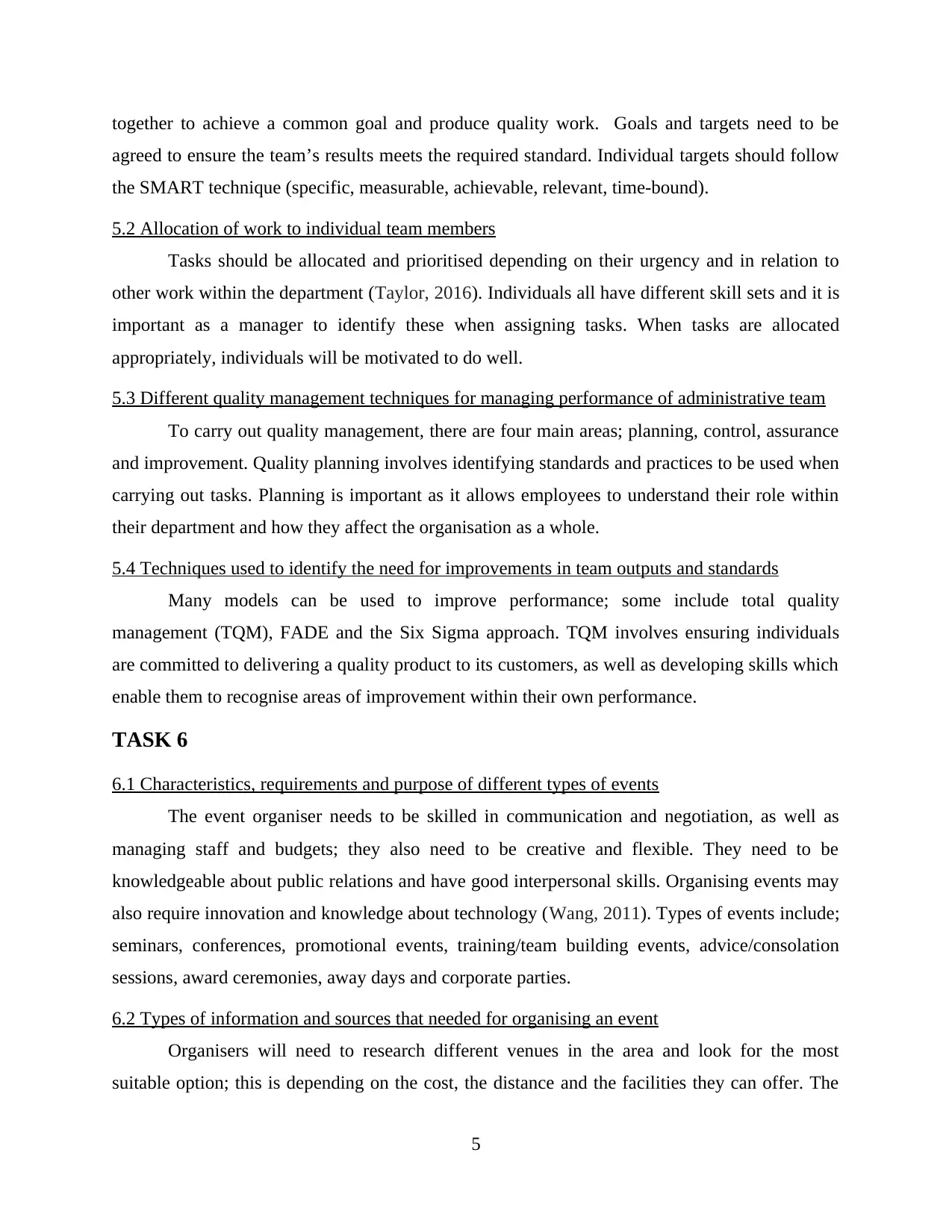
together to achieve a common goal and produce quality work. Goals and targets need to be
agreed to ensure the team’s results meets the required standard. Individual targets should follow
the SMART technique (specific, measurable, achievable, relevant, time-bound).
5.2 Allocation of work to individual team members
Tasks should be allocated and prioritised depending on their urgency and in relation to
other work within the department (Taylor, 2016). Individuals all have different skill sets and it is
important as a manager to identify these when assigning tasks. When tasks are allocated
appropriately, individuals will be motivated to do well.
5.3 Different quality management techniques for managing performance of administrative team
To carry out quality management, there are four main areas; planning, control, assurance
and improvement. Quality planning involves identifying standards and practices to be used when
carrying out tasks. Planning is important as it allows employees to understand their role within
their department and how they affect the organisation as a whole.
5.4 Techniques used to identify the need for improvements in team outputs and standards
Many models can be used to improve performance; some include total quality
management (TQM), FADE and the Six Sigma approach. TQM involves ensuring individuals
are committed to delivering a quality product to its customers, as well as developing skills which
enable them to recognise areas of improvement within their own performance.
TASK 6
6.1 Characteristics, requirements and purpose of different types of events
The event organiser needs to be skilled in communication and negotiation, as well as
managing staff and budgets; they also need to be creative and flexible. They need to be
knowledgeable about public relations and have good interpersonal skills. Organising events may
also require innovation and knowledge about technology (Wang, 2011). Types of events include;
seminars, conferences, promotional events, training/team building events, advice/consolation
sessions, award ceremonies, away days and corporate parties.
6.2 Types of information and sources that needed for organising an event
Organisers will need to research different venues in the area and look for the most
suitable option; this is depending on the cost, the distance and the facilities they can offer. The
5
agreed to ensure the team’s results meets the required standard. Individual targets should follow
the SMART technique (specific, measurable, achievable, relevant, time-bound).
5.2 Allocation of work to individual team members
Tasks should be allocated and prioritised depending on their urgency and in relation to
other work within the department (Taylor, 2016). Individuals all have different skill sets and it is
important as a manager to identify these when assigning tasks. When tasks are allocated
appropriately, individuals will be motivated to do well.
5.3 Different quality management techniques for managing performance of administrative team
To carry out quality management, there are four main areas; planning, control, assurance
and improvement. Quality planning involves identifying standards and practices to be used when
carrying out tasks. Planning is important as it allows employees to understand their role within
their department and how they affect the organisation as a whole.
5.4 Techniques used to identify the need for improvements in team outputs and standards
Many models can be used to improve performance; some include total quality
management (TQM), FADE and the Six Sigma approach. TQM involves ensuring individuals
are committed to delivering a quality product to its customers, as well as developing skills which
enable them to recognise areas of improvement within their own performance.
TASK 6
6.1 Characteristics, requirements and purpose of different types of events
The event organiser needs to be skilled in communication and negotiation, as well as
managing staff and budgets; they also need to be creative and flexible. They need to be
knowledgeable about public relations and have good interpersonal skills. Organising events may
also require innovation and knowledge about technology (Wang, 2011). Types of events include;
seminars, conferences, promotional events, training/team building events, advice/consolation
sessions, award ceremonies, away days and corporate parties.
6.2 Types of information and sources that needed for organising an event
Organisers will need to research different venues in the area and look for the most
suitable option; this is depending on the cost, the distance and the facilities they can offer. The
5
⊘ This is a preview!⊘
Do you want full access?
Subscribe today to unlock all pages.

Trusted by 1+ million students worldwide
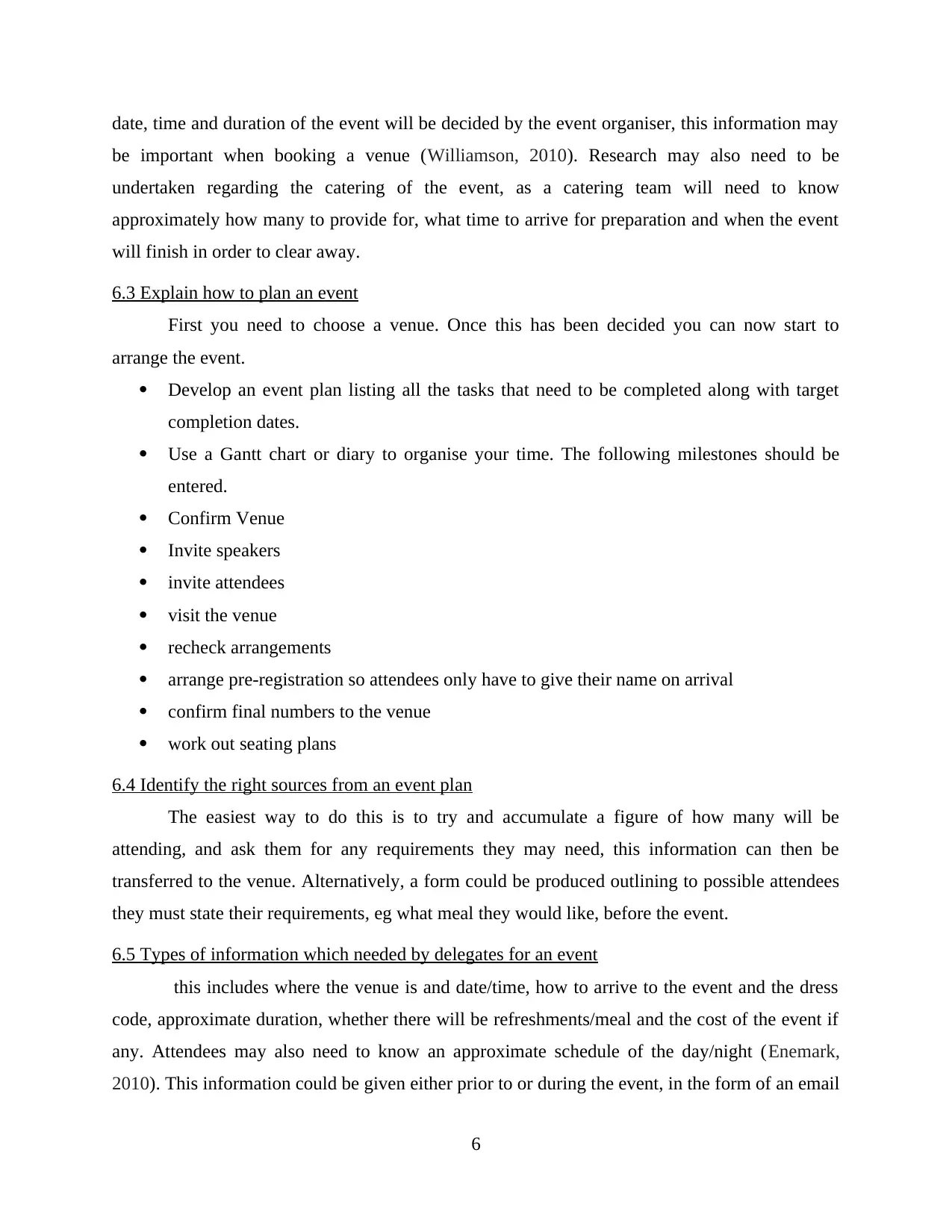
date, time and duration of the event will be decided by the event organiser, this information may
be important when booking a venue (Williamson, 2010). Research may also need to be
undertaken regarding the catering of the event, as a catering team will need to know
approximately how many to provide for, what time to arrive for preparation and when the event
will finish in order to clear away.
6.3 Explain how to plan an event
First you need to choose a venue. Once this has been decided you can now start to
arrange the event.
Develop an event plan listing all the tasks that need to be completed along with target
completion dates.
Use a Gantt chart or diary to organise your time. The following milestones should be
entered.
Confirm Venue
Invite speakers
invite attendees
visit the venue
recheck arrangements
arrange pre-registration so attendees only have to give their name on arrival
confirm final numbers to the venue
work out seating plans
6.4 Identify the right sources from an event plan
The easiest way to do this is to try and accumulate a figure of how many will be
attending, and ask them for any requirements they may need, this information can then be
transferred to the venue. Alternatively, a form could be produced outlining to possible attendees
they must state their requirements, eg what meal they would like, before the event.
6.5 Types of information which needed by delegates for an event
this includes where the venue is and date/time, how to arrive to the event and the dress
code, approximate duration, whether there will be refreshments/meal and the cost of the event if
any. Attendees may also need to know an approximate schedule of the day/night (Enemark,
2010). This information could be given either prior to or during the event, in the form of an email
6
be important when booking a venue (Williamson, 2010). Research may also need to be
undertaken regarding the catering of the event, as a catering team will need to know
approximately how many to provide for, what time to arrive for preparation and when the event
will finish in order to clear away.
6.3 Explain how to plan an event
First you need to choose a venue. Once this has been decided you can now start to
arrange the event.
Develop an event plan listing all the tasks that need to be completed along with target
completion dates.
Use a Gantt chart or diary to organise your time. The following milestones should be
entered.
Confirm Venue
Invite speakers
invite attendees
visit the venue
recheck arrangements
arrange pre-registration so attendees only have to give their name on arrival
confirm final numbers to the venue
work out seating plans
6.4 Identify the right sources from an event plan
The easiest way to do this is to try and accumulate a figure of how many will be
attending, and ask them for any requirements they may need, this information can then be
transferred to the venue. Alternatively, a form could be produced outlining to possible attendees
they must state their requirements, eg what meal they would like, before the event.
6.5 Types of information which needed by delegates for an event
this includes where the venue is and date/time, how to arrive to the event and the dress
code, approximate duration, whether there will be refreshments/meal and the cost of the event if
any. Attendees may also need to know an approximate schedule of the day/night (Enemark,
2010). This information could be given either prior to or during the event, in the form of an email
6
Paraphrase This Document
Need a fresh take? Get an instant paraphrase of this document with our AI Paraphraser
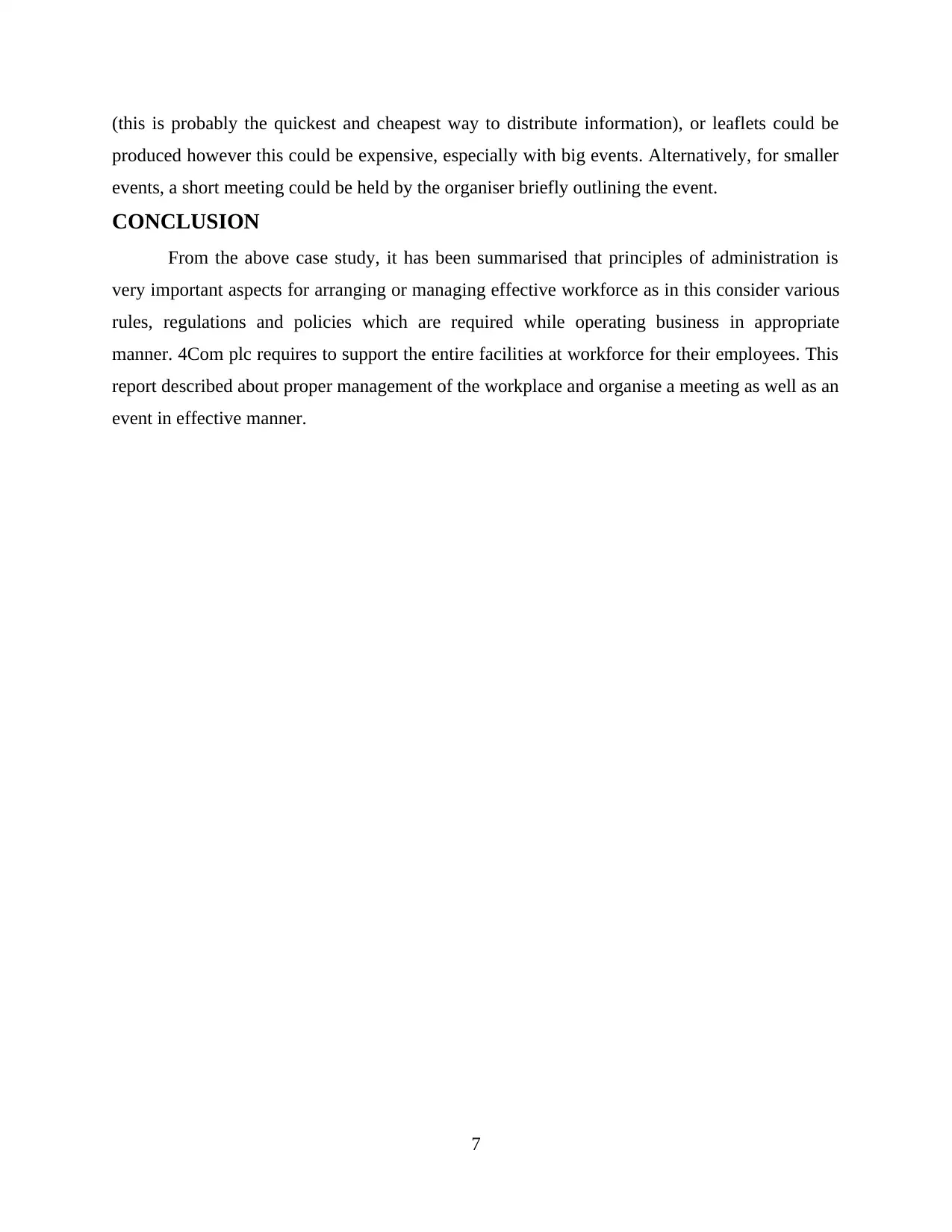
(this is probably the quickest and cheapest way to distribute information), or leaflets could be
produced however this could be expensive, especially with big events. Alternatively, for smaller
events, a short meeting could be held by the organiser briefly outlining the event.
CONCLUSION
From the above case study, it has been summarised that principles of administration is
very important aspects for arranging or managing effective workforce as in this consider various
rules, regulations and policies which are required while operating business in appropriate
manner. 4Com plc requires to support the entire facilities at workforce for their employees. This
report described about proper management of the workplace and organise a meeting as well as an
event in effective manner.
7
produced however this could be expensive, especially with big events. Alternatively, for smaller
events, a short meeting could be held by the organiser briefly outlining the event.
CONCLUSION
From the above case study, it has been summarised that principles of administration is
very important aspects for arranging or managing effective workforce as in this consider various
rules, regulations and policies which are required while operating business in appropriate
manner. 4Com plc requires to support the entire facilities at workforce for their employees. This
report described about proper management of the workplace and organise a meeting as well as an
event in effective manner.
7
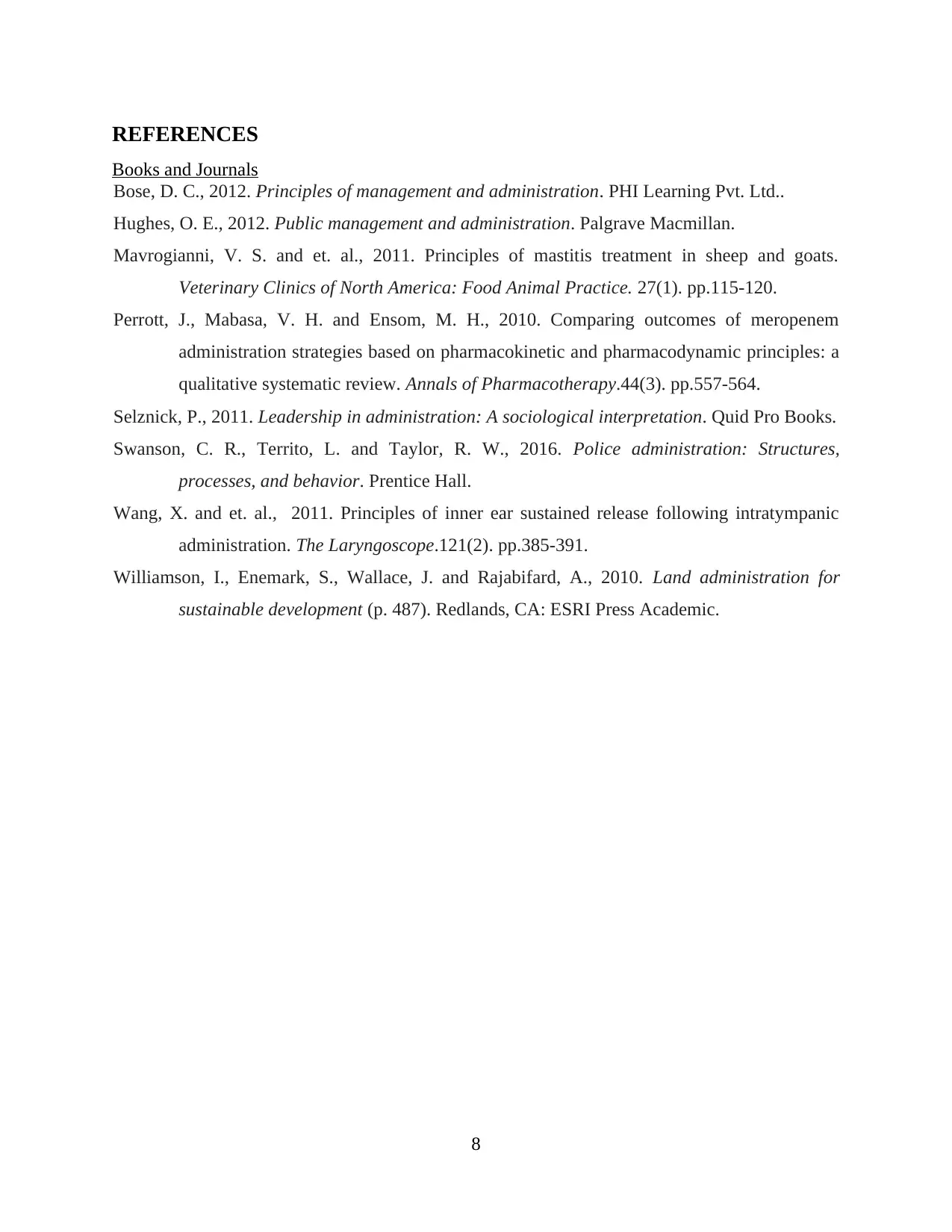
REFERENCES
Books and Journals
Bose, D. C., 2012. Principles of management and administration. PHI Learning Pvt. Ltd..
Hughes, O. E., 2012. Public management and administration. Palgrave Macmillan.
Mavrogianni, V. S. and et. al., 2011. Principles of mastitis treatment in sheep and goats.
Veterinary Clinics of North America: Food Animal Practice. 27(1). pp.115-120.
Perrott, J., Mabasa, V. H. and Ensom, M. H., 2010. Comparing outcomes of meropenem
administration strategies based on pharmacokinetic and pharmacodynamic principles: a
qualitative systematic review. Annals of Pharmacotherapy.44(3). pp.557-564.
Selznick, P., 2011. Leadership in administration: A sociological interpretation. Quid Pro Books.
Swanson, C. R., Territo, L. and Taylor, R. W., 2016. Police administration: Structures,
processes, and behavior. Prentice Hall.
Wang, X. and et. al., 2011. Principles of inner ear sustained release following intratympanic
administration. The Laryngoscope.121(2). pp.385-391.
Williamson, I., Enemark, S., Wallace, J. and Rajabifard, A., 2010. Land administration for
sustainable development (p. 487). Redlands, CA: ESRI Press Academic.
8
Books and Journals
Bose, D. C., 2012. Principles of management and administration. PHI Learning Pvt. Ltd..
Hughes, O. E., 2012. Public management and administration. Palgrave Macmillan.
Mavrogianni, V. S. and et. al., 2011. Principles of mastitis treatment in sheep and goats.
Veterinary Clinics of North America: Food Animal Practice. 27(1). pp.115-120.
Perrott, J., Mabasa, V. H. and Ensom, M. H., 2010. Comparing outcomes of meropenem
administration strategies based on pharmacokinetic and pharmacodynamic principles: a
qualitative systematic review. Annals of Pharmacotherapy.44(3). pp.557-564.
Selznick, P., 2011. Leadership in administration: A sociological interpretation. Quid Pro Books.
Swanson, C. R., Territo, L. and Taylor, R. W., 2016. Police administration: Structures,
processes, and behavior. Prentice Hall.
Wang, X. and et. al., 2011. Principles of inner ear sustained release following intratympanic
administration. The Laryngoscope.121(2). pp.385-391.
Williamson, I., Enemark, S., Wallace, J. and Rajabifard, A., 2010. Land administration for
sustainable development (p. 487). Redlands, CA: ESRI Press Academic.
8
⊘ This is a preview!⊘
Do you want full access?
Subscribe today to unlock all pages.

Trusted by 1+ million students worldwide
1 out of 12
Related Documents
Your All-in-One AI-Powered Toolkit for Academic Success.
+13062052269
info@desklib.com
Available 24*7 on WhatsApp / Email
![[object Object]](/_next/static/media/star-bottom.7253800d.svg)
Unlock your academic potential
Copyright © 2020–2025 A2Z Services. All Rights Reserved. Developed and managed by ZUCOL.





